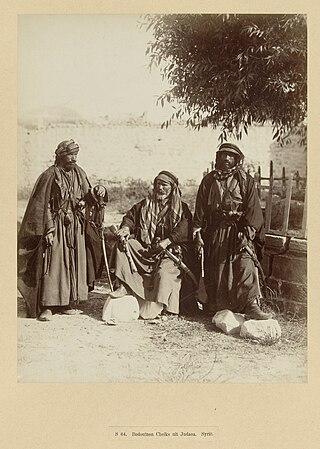
The Bedouin, Beduin, or Bedu are pastorally nomadic Arab tribes who have historically inhabited the desert regions in the Arabian Peninsula, North Africa, the Levant, and Mesopotamia (Iraq). The Bedouin originated in the Syrian Desert and Arabian Desert but spread across the rest of the Arab world in West Asia and North Africa after the spread of Islam. The English word bedouin comes from the Arabic badawī, which means "desert-dweller", and is traditionally contrasted with ḥāḍir, the term for sedentary people. Bedouin territory stretches from the vast deserts of North Africa to the rocky ones of the Middle East. They are sometimes traditionally divided into tribes, or clans, and historically share a common culture of herding camels, sheep and goats. The vast majority of Bedouins adhere to Islam, although there are some fewer numbers of Christian Bedouins present in the Fertile Crescent.

The Tuareg people are a large Berber ethnic group, traditionally nomadic pastoralists, who principally inhabit the Sahara in a vast area stretching from far southwestern Libya to southern Algeria, Niger, Mali, and Burkina Faso, as far as northern Nigeria.
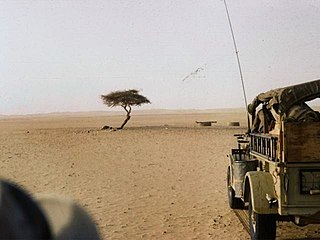
The Ténéré Tree was a solitary acacia that was once considered the most isolated tree on Earth. It was a landmark on caravan routes through the Ténéré region of the Sahara Desert in northeast Niger, so well known that it and the Arbre Perdu to the north are the only trees to be shown on a map at a scale of 1:4,000,000. The tree is estimated to have existed for approximately 300 years until it was knocked down in 1973 by a truck driver.

Sir Wilfred Patrick Thesiger, also known as Mubarak bin Landan was a British military officer, explorer, and writer. Thesiger's travel books include Arabian Sands (1959), on his foot and camel crossing of the Empty Quarter of the Arabian Peninsula, and The Marsh Arabs (1964), on his time living with the Marsh Arabs of Iraq.

Agadez, formerly spelled Agadès, is the fifth largest city in Niger, with a population of 110,497 based on the 2012 census. The capital of the eponymous Agadez Region, the city lies in the Sahara desert, and is also the capital of Aïr, one of the traditional Tuareg–Berber federations. The historic centre of the town has been designated a World Heritage Site by UNESCO.
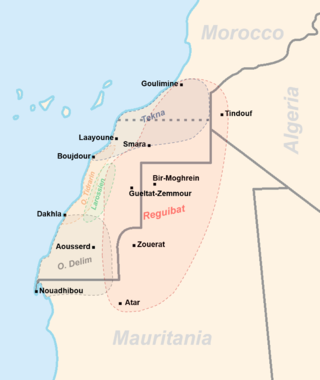
The Sahrawis, or Sahrawi people, are an ethnic group native to the western part of the Sahara desert, which includes the Western Sahara, southern Morocco, much of Mauritania, and along the southwestern border of Algeria. They are of mixed Hassani Arab and Sanhaji Berber descent, as well as West African and other indigenous populations.
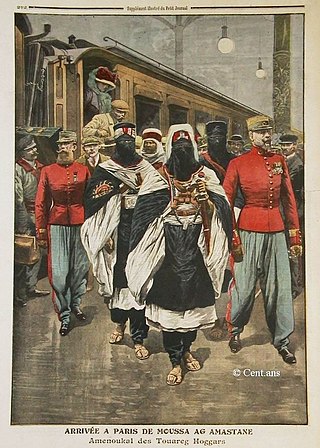
Musa Ag Amastan (1867–1920) was the Chief (Amenokal) of the Kel Ahaggar Tuareg from 1905 to 1920. Based in the Ahaggar, he formed part of the Kel Ghela.
Frank Cole was a Canadian filmmaker who became the first North American to cross the Sahara alone on camel from the Atlantic Ocean to the Red Sea, in 1990. This voyage earned Cole an entry in the Guinness Book of World Records. His documentary Life Without Death chronicled his experience and won him several awards as well as being released theatrically in Paris. Cole was murdered by bandits near Timbuktu, Mali, in late October 2000.

The Afar, also known as the Danakil, Adali and Odali, are a Cushitic ethnic group inhabiting the Horn of Africa. They primarily live in the Afar Region of Ethiopia and in northern Djibouti, as well as the entire southern coast of Eritrea. The Afar speak the Afar language, which is part of the Cushitic branch of the Afroasiatic family. Afars are the only inhabitants of the Horn of Africa whose traditional territories border both the Red Sea and the Gulf of Aden.
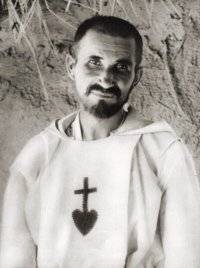
Charles Eugène, vicomte de Foucauld de Pontbriand,, commonly known as Charles de Foucauld, was a French soldier, explorer, geographer, ethnographer, Catholic priest and hermit who lived among the Tuareg people in the Sahara in Algeria. He was assassinated in 1916. His inspiration and writings led to the founding of a number of religious communities inspired by his example, such as the Little Brothers of Jesus.
Méhariste is a French word that roughly translates to camel cavalry. The word is most commonly used as a designation of military units.

The Reguibat is a Sahrawi tribal confederation of mixed Arab and Sanhaja Berber origins. The Reguibat speak Hassaniya Arabic, and are Arab in culture. They claim descent from Sidi Ahmed al-Reguibi, an Arab Islamic preacher from Beni Hassan who settled in Saguia el-Hamra in 1503. They also believe that they are, through him, a chorfa tribe, i.e. descendants of Muhammad. Religiously, they belong to the Maliki school of Sunni Islam.

The Oulad Delim are a Bedouin Sahrawi tribe of Arab descent which originated in Yemen. They are descended from Delim bin Hassan, who was from the Ma'qili tribe of Beni Hassan which settled in the Sahara in the 12th century. They were formerly considered of Hassane status i.e. part of the ruling warrior stratum. The Oulad Delim speak Hassaniya Arabic, a Bedouin dialect which is very close to pure classical Arabic. They traditionally live in the southern regions of Western Sahara, especially around the city of Dakhla. They are also found in Morocco in the region of Rabat, Marrakech, Sidi Kacem and El Jadida, where their ancestors received lands from the Moroccan sultans for their participation in warfare, as a Guich tribe, as well as in Mauritania in the region between Nouadhibou and Idjil.
Desert exploration is the deliberate and scientific exploration of deserts, the arid regions of the earth. It is only incidentally concerned with the culture and livelihood of native desert dwellers. People have struggled to live in deserts and the surrounding semi-arid lands for millennia. Nomads have moved their flocks and herds to wherever grazing is available, and oases have provided opportunities for a more settled way of life. Many, such as the Bushmen in the Kalahari, the Aborigines in Australia and various Indigenous peoples of the Americas, were originally hunter-gatherers. Many trade routes have been forged across deserts, especially across the Sahara Desert, and traditionally were used by caravans of camels carrying salt, gold, ivory and other goods. Large numbers of slaves were also taken northwards across the Sahara. Today, some mineral extraction also takes place in deserts, and the uninterrupted sunlight gives potential for the capture of large quantities of solar energy.

The Sahara International Film Festival, also known as FiSahara, is an annual event which takes place in the Sahrawi refugee camps, at the southwest corner of Algeria, near the border with Western Sahara. It is the only film festival in the world held in a refugee camp. The first festival was in large part organised by Peruvian film director Javier Corcuera.

Henri Lhote was a French explorer, ethnographer, and discoverer of prehistoric cave art. He is credited with the discovery of an assembly of 800 or more works of primitive art in a remote region of Algeria on the edge of the Sahara desert.

Désert is a 1980 novel written by French Nobel laureate writer J. M. G. Le Clézio, considered to be one of his breakthrough novels. It won the Académie française's Grand Prix Paul Morand in 1980.
Eamonn Gearon is an author, Arabist, and analyst. Gearon's career goal has been the development of understanding and insight between the Greater Middle East and the West. Gearon is best known for his book The Sahara: A Cultural History (2011).

The Tan-Tan Moussem is an annual gathering held since 1963 by more than thirty tribes from southern Morocco and other parts of Northwest Africa in Tan-Tan, a town in south-western Morocco. In traditional Berber culture, a moussem is "a type of annual fair with economic, cultural and social functions."

Targui is a board game published in 1988 by Jumbo Games that simulates warfare between Touareg tribes of North Africa to acquire economically strong territories.















